This post may contain affiliate links. Please read our disclosure policy.
This delicious Pierogi recipe has been passed down through generations. Includes four different filling options!
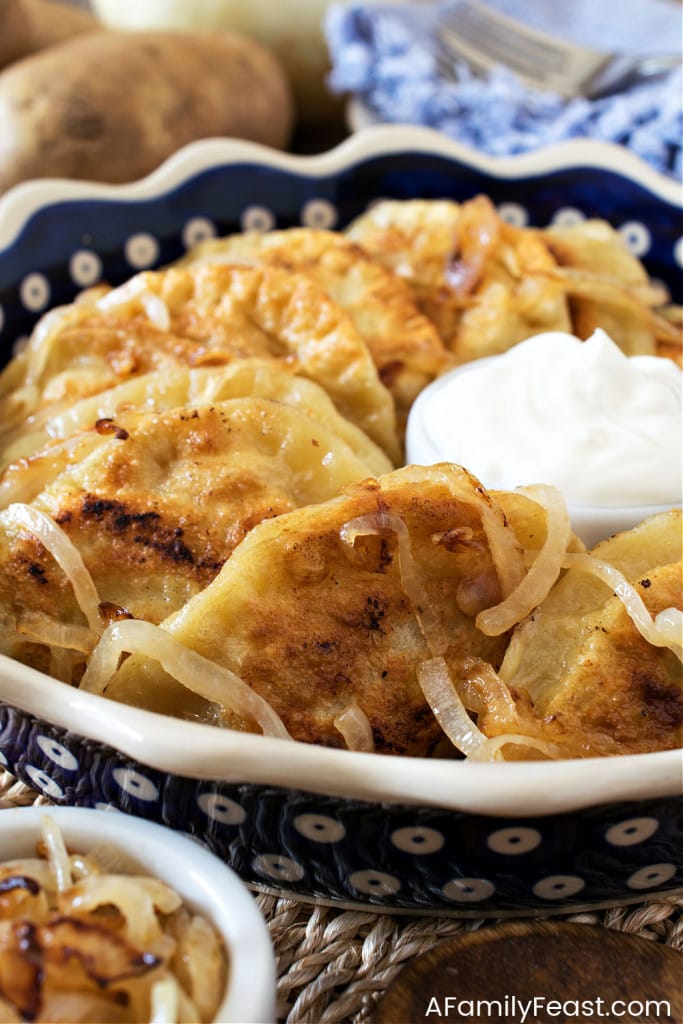
100+ Year Old Family Recipe
This Pierogi recipe is one that is near and dear to my heart. I grew up in a family that was Polish on both sides, and today’s recipe is adapted from the one that my grandmother (we called her Babci) on my mother’s side of the family shared with our family.
This 100+ year old pierogi recipe is a traditional Polish dish that was always served at our family’s Easter and Christmas dinners.
Every year, my mother would get together with my Babci and my Cioci Bertha (Babcia is ‘grandmother’ and ‘Ciocia’ is aunt in Polish; our family dropped the ‘a’ at the end) in the weeks leading up to the holidays. Together they would make a giant batch of pierogi with a mix of different fillings. Some would be served at the holiday meal and others would be frozen to be enjoyed throughout the year.
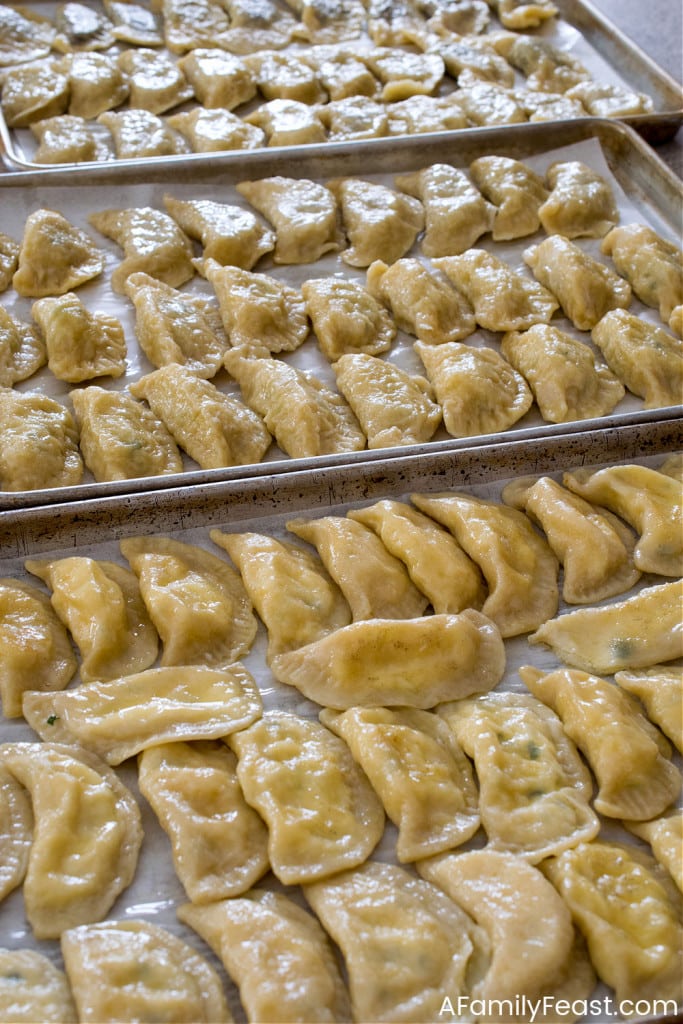
What are Pierogi?
Pierogi are unleavened dumplings from a simple, egg, water, and flour-based dough that are stuffed with a variety of fillings – savory or sweet. After filling and crimping the edges, pierogi are are boiled in a pot of water until they float.
Sometimes, they are served simply with melted butter on top. After boiling, my family liked to fry our pierogi with butter and onions until golden brown and slightly crispy. Then, we’d serve them with sour cream on the side for dipping.
Reader Recipe Review
This is the first time I have attempted pierogies since my Mom passed away…IT TURNED OUT PERFECT!!! – Deb
Why You’ll Love Pierogi
- It’s delicious comfort food – just like Babcia used to make!
- Pillowy, tender dough is filled with a variety of delicious fillings – both savory and sweet.
- You can make a big batch, then freeze some to enjoy when the craving strikes.
- Pierogi are made with simple ingredients you probably have on hand in your pantry.
Helpful Tip
Making pierogi can be labor-intensive – so ask family or friends to help. (We even get the kids involved!)
While one or two people cut, fill and crimp the dumplings, another person can be boiling and frying them. Make a big batch to share with everyone or freeze some for later.
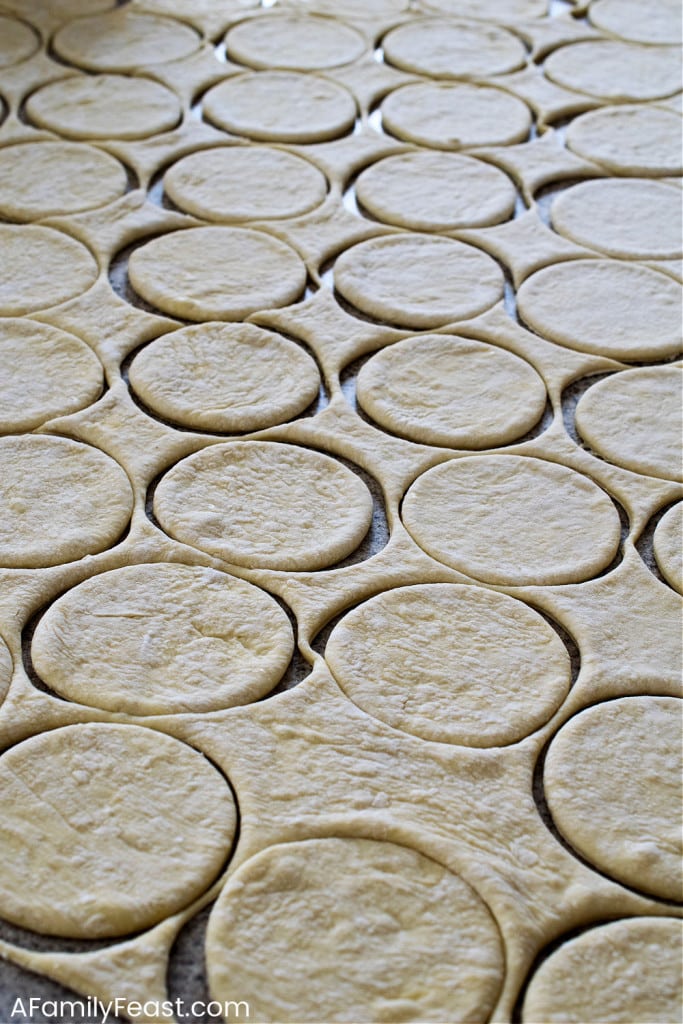
Key Ingredients & Substitutions
- Flour – All-purpose flour is used in the dough, as well as for dusting the countertop as you roll out the dough.
- Salt – For seasoning the dough.
- Eggs
- Water
- Sour Cream – (Optional) My grandmother’s original pierogi recipe did not include sour cream, but after testing some other recipes that did include sour cream in the dough, we felt that adding sour cream made the dough much more tender, as well as easier to work with.
- Fillings – Most often we’d make pierogi filled with farmer’s cheese, sauerkraut and mushrooms, or potato and cheddar. Another aunt of mine – my Cioci Doris – also made a prune-filled dessert pierogi which are surprisingly delicious served with buttered bread crumbs sprinkled on top!
- Butter, Onions and More Sour Cream – For serving
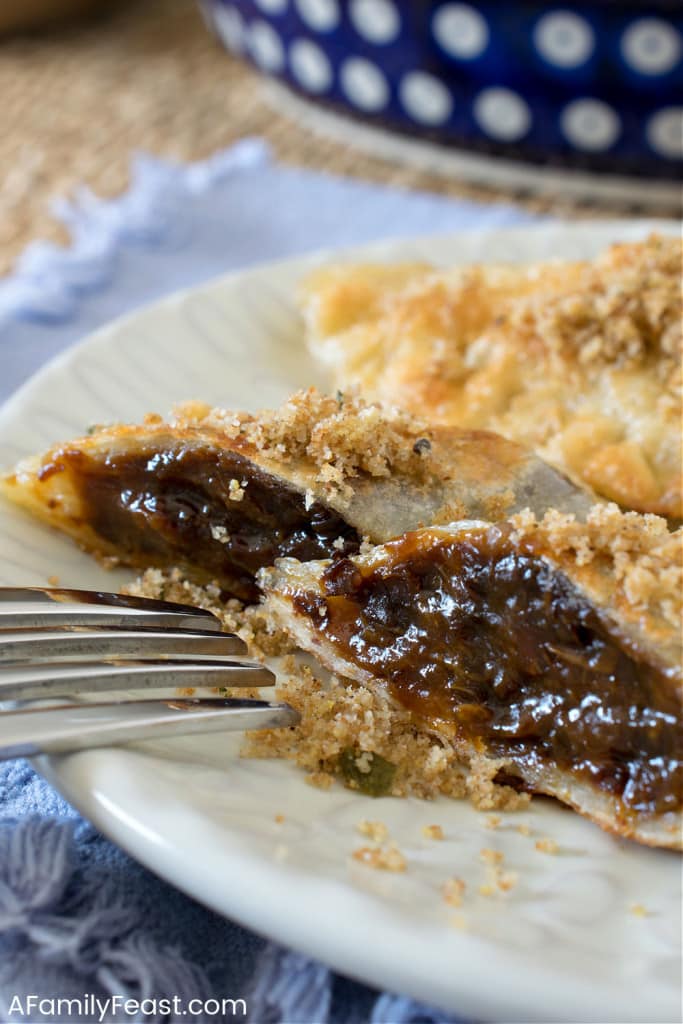
A Few Notes About the Different Fillings
- In the recipe card below, we’ve included four different filling options for you to try – and enough pierogi dough to make all of the versions!
- Feel free to cut the recipe back if you want to make fewer fillings.
- We highly recommend that you make the different fillings a day ahead of time to allow them to cool before handling.
Special Tools Needed
- 3″ round biscuit or cookie cutter, an empty glass or can with a 3-inch diameter
- Bench scraper (optional)
- Pierogi maker (optional)
- Sheet tray(s) and parchment paper
- Pastry brush
- Large pot to boil water
- Large skillet to brown the pierogi
Helpful Tip
When making pierogi with different fillings, it can sometimes be hard to tell which dumpling has which filling.
Use a fork to crimp the edges in different patterns – some straight all along the edges, others criss-cross, and others plain.
Or use a pierogi maker like this.
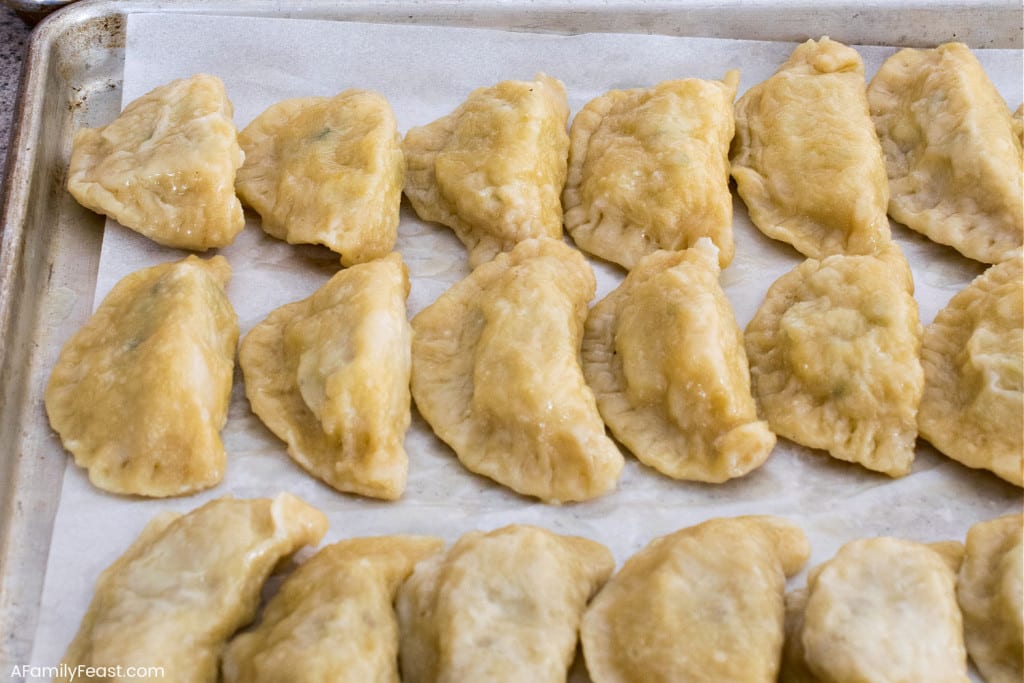
How do I make Pierogi?
- Prepare the fillings and let cool as needed.
- Mix the dough by combining flour and salt together on a clean work surface such as the kitchen countertop or a large pastry board. Make a well in the center of the flour.
- Add eggs and sour cream to the center of the well. With a fork, start stirring the egg mixture, gradually adding in flour from the sides of the well and adding water as you go, until the dough is soft and pliable.
- Flour the countertop, then roll out the dough to 1/16th-inch thickness.
- Cut circles into the dough, dipping the cutter into flour (if needed) to prevent sticking.
- Divide the filling among the dumpling circles. (This will work out to be about 3/4 to 1 ounce per dumpling) – you can use a small scoop or two teaspoons to portion the filling out.
- Close the dumplings – one by one – by brushing half of the circle with water, then folding the dumpling in half and pinching the edges to close. (See process photos in the recipe card below.) Make sure that no filling is poking out – you’ll want a good seal for boiling. You can also use a fork to crimp the edges if you’d like.
- Place the dumplings on a parchment-lined sheet tray as you repeat this last step for the remaining filling and dough. Brush off any excess flour from the filled pierogi. You may also cover dumplings on the sheet tray with a towel to prevent them from drying out.
- Bring a large pot of water to a boil. At the same time, melt some butter in a large skillet keeping warm over low heat.
- Boil the pierogi (in batches) until they float, then remove them from the water – with a slotted spoon or spider strainer – directly into the skillet with the melted butter. Repeat with the remaining pierogi.
- Serve pierogi with the melted butter, or fry (in batches) until golden brown and crispy, with fried onions and sour cream on the side.
- To Freeze Some of the Pierogi – You can freeze them uncooked, right after filling. Or, after boiling and coating with butter, place the pierogi on a parchment-lined sheet tray a freeze until firm. Once frozen, you can place them into a freezer bag for storage up to six months.
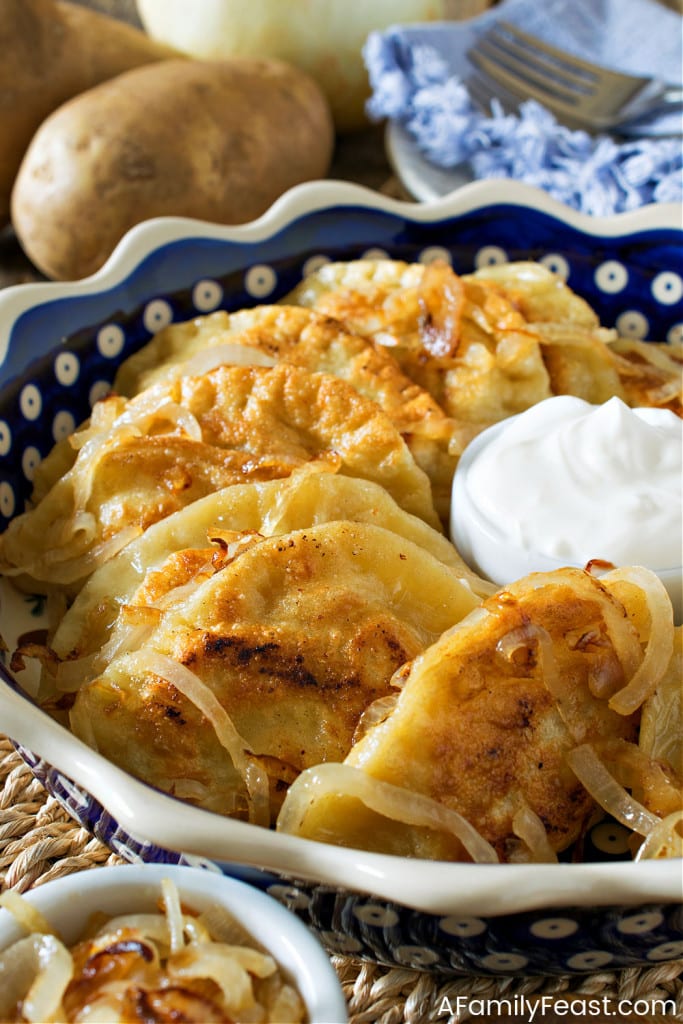
A Few Notes About the Dough
- The dough recipe below makes enough for 100 pierogi – and enough for all of the different filling recipes we included.
- Feel free to cut the recipe back if you want to make fewer.
- The dough is best freshly mixed on the day when you plan to assemble the pierogi. It should be rolled at room temperature – do not chill before rolling.
- If the dough is not easily rolling out, give it a chance to rest so the gluten can relax.
Frequently Asked Questions
- How do I freeze my pierogi? You can freeze them filled and uncooked. Or, after boiling and coating with butter, place the pierogi on a parchment-lined sheet tray and freeze until firm. Once frozen, you can place the dumplings into a zipper-seal freezer bag for easy access. Store in the freezer for up to six months.
- How do I thaw my pierogi? We allow the dumplings to thaw in the refrigerator, then reheat in a skillet with melted butter to brown and crisp up.
- My pierogi dough is too tough to roll out. What can I do? Sometimes, allowing the dough to rest for a while will help. The gluten will have to relax as it rests, making it easier to handle. Just be sure to keep it covered so the dough doesn’t dry out, and keep it room temperature.
- Can I use a food processor or stand mixer to make the dough? Yes – we’ve had several readers write to tell us that they used a food processor or a stand mixer with dough hook to mix up the dough. Just be sure to avoid over-processing – that will develop the gluten in the flour, making the dough tough.
- Can I use gluten-free flour? We haven’t tried making gluten-free pierogi ourselves, but one of our readers in the comments below suggested following a gluten-free pasta recipe with sticky rice flour added to achieve the proper elasticity of the dough. She also suggested that you shouldn’t roll out the dough as thin as we did in our recipe.
- How do I make fruit pierogi? Scroll below to the comment section. Some of our readers shared their blueberry, strawberry, and plum pierogi recipes in the comments.
This post originally appeared on A Family Feast in May 2015. The delicious recipe remains the same but we’ve updated the post with additional information and helpful hints.
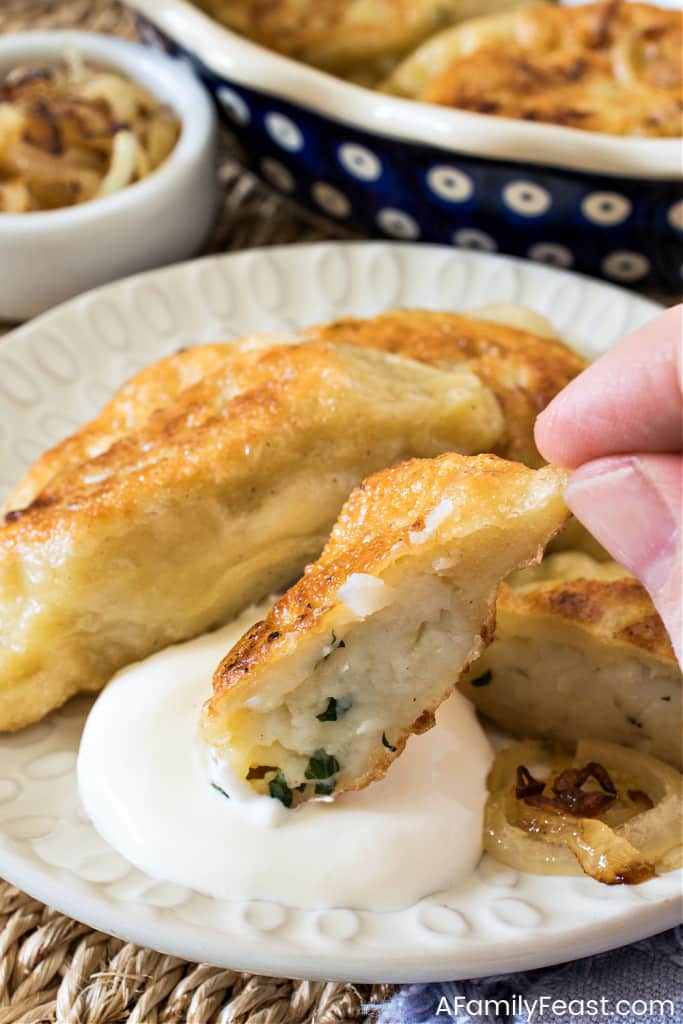
You may like these other Polish recipes:
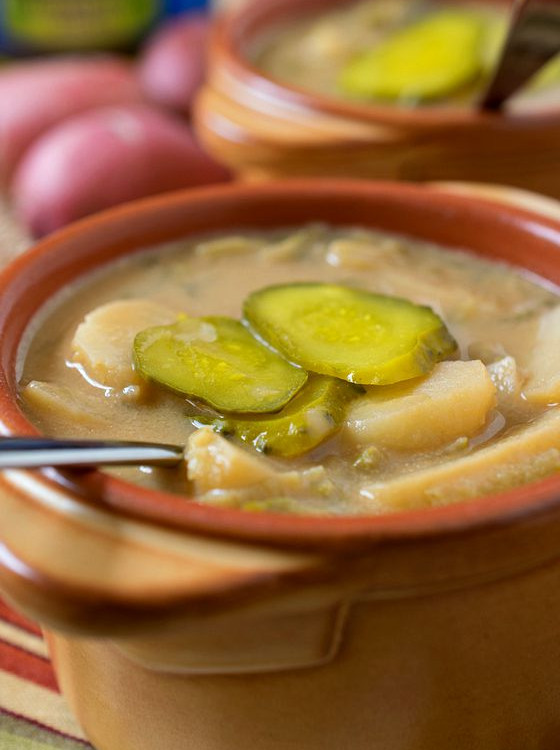
More Delicious Polish Recipes!
See the recipesWe love seeing what you made! Tag us on Instagram at @afamilyfeast or hashtag #afamilyfeast so we can see your creations!

Pierogi
A Few Notes:
- We find it easiest to make the fillings ahead of time – even the day before you start to make the dough for the dumplings.
- The dough makes approximately 100 three-inch pierogi, if dough is rolled to 1/16th inch thick. Each filling recipe listed below yields potato = 22, cheese = 40, kraut = 26 and prune = 16.
- The dough for this recipe does not need to be made ahead and in fact should be made, rolled and filled right away as it will dry out if made too far ahead. The dough is soft and very easy to work with as soon as it’s mixed. Additionally these can be made ahead and frozen prior to boiling and frying. To do this, freeze flat on parchment lined sheet pans and once frozen, place in zipper sealed gallon bags and place back in the freezer. When ready to use, follow process below to boil and fry.
Ingredients
For the Dough – Makes 100 Pierogi
- 7 ½ cups all-purpose flour, plus more for rolling and dusting
- 1 ½ teaspoons kosher salt
- 2 whole eggs
- 1/3 cup sour cream
- 2 ½ to 3 cups room temperature water
For the Potato Filling – Makes 22
- 1 pound russet potatoes, peeled and diced into 2 inch pieces
- 2 tablespoons unsalted butter
- ½ cup onions diced
- ½ teaspoon kosher salt
- Few grinds black pepper
- 1 tablespoon chopped fresh parsley
- ½ cup sharp cheddar cheese
For the Sauerkraut Filling – Makes 26
- 2 tablespoons unsalted butter
- 1 cup button mushrooms diced fine
- ½ cup onion diced fine
- 1 14.5-ounce can sauerkraut, well drained and squeezed of liquid
- ½ teaspoon kosher salt
- ¼ teaspoon freshly ground black pepper
For the Cheese Filling – Makes 40
- 2 tablespoons unsalted butter
- ½ cup onion diced
- 1 pound farmer’s cheese crumbled (this is a cheese similar in texture to feta but without the briny taste)
- 1 whole egg beaten
- Salt & pepper to taste
- 1 tablespoon fresh parsley chopped
For the Prune Filling – Makes 16
- 1 cup dry pitted prunes
- 1 tablespoon granulated sugar
- 1 teaspoon fresh lemon juice
- 2 tablespoons plain breadcrumbs
- 1 tablespoon unsalted butter
Additional ingredients
- 2 tablespoon of melted butter for every 25 pierogi (to coat them so they don’t stick)
- Onions – approximately ½ pound thinly sliced onions for each 25 pierogi
- 2 tablespoons butter for every ½ pound of onions
- Sour cream, as needed to serve with the savory pierogi
Instructions
To Make the Dough
- On a clean work surface, place all of the 7½ cups of flour into a pile. Stir in salt then make a valley in the center of the flour. Crack both eggs into center along with sour cream. With a fork, start stirring the eggs and sour cream into the flour pulling the edges toward the center. Then gradually add the water a little at a time as you continue to stir with a fork. You may not use all of the water so after 2 cups check texture and slowly incorporate another half cup of water. (Our dough was a perfect consistency at 2½ cups and we did not use the remaining ½ cup.) The texture should be soft and sticky to the touch.
- (A scraper like this is helpful for this next step so you can scrape and mold the dough as it is floured and rolled.) Sprinkle flour over the top of the dough ball and surrounding counter and with the scraper (or a flat spatula if you don’t have one), scrape dough from counter over onto floured surface and continue this process adding flour as needed until you have a soft, pliable easy-to-handle dough that does not stick to the rolling pin.
- Using a rolling pin, roll the dough mass out to 1/16th inch thin. If you roll it out any thicker, your yield will be less than 100.
- As you roll, keep flouring the counter under the dough so when it is completely rolled out, none of the dough mass sticks to your counter.
- Using a 3 inch round cookie or biscuit cutter, dip the cutter in flour if needed then cut out the circles as close to each other as possible. After filling this batch, gather up the scraps and roll back out and cut more circles. Finally roll up the last of the scraps and cut one last time. The dough is soft enough to get rolled out three times but no more. Also try to keep the dough covered with a slightly damp cloth to keep the dough from drying out.
- The final count should be approximately 100 circles. See last step for filling, boiling and frying.
To Make the Potato Filling
- Boil potatoes in salted water for 5-10 minutes until tender, then drain and place back into the pan. Heat over medium just long enough to evaporate any liquid left in the pan and to dry out the potatoes. Remove to a bowl and set aside.
- In the same pan, melt butter over medium heat and add onion, salt and pepper and cook 3-5 minutes until tender. Remove from heat and add parsley and potatoes and using a potato masher, mash mixture to somewhat fine. Stir in cheddar cheese and set mixture aside. If not filling right away, refrigerate until needed.
To Make Sauerkraut Filling
- In a medium sauté pan, melt butter over medium heat and add mushroom and onion and cook for 3-5 minutes until tender. Add drained sauerkraut, salt and pepper. Stir and remove from heat. If not filling right away, refrigerate until needed.
To Make the Cheese Filling
- In a medium sauté pan over medium heat, melt butter and add onions. Cook 3-5 minutes and remove from heat. Stir in Farmer’s cheese and mix to combine. Stir in egg, parsley, salt and pepper and stir again. If not filling right away, refrigerate until needed.
To Make the Prune filling
- Note: This is more of a dessert filling and can be served a few different ways. But the traditional way is, once cooked, serve with buttered and toasted plain bread crumbs.
- In a small sauce pan place dried prunes and water just to cover tops. Add sugar and lemon and bring to a boil. Lower to a simmer and cook two minutes. Remove from heat and let the prunes sit in the hot water for ten minutes. Drain liquid and discard. Place cooked prunes in a blender or small food processor (like this one) and puree until smooth. If not filling right away, refrigerate until needed. Brown the ¼ cup of bread crumbs in the one tablespoon of butter over medium heat until slightly browned, about 4-5 minutes. Set aside for serving.
To Fill, Prepare and Cook the Pierogi
- Each pierogi gets filled and cooked the same. As noted above, the prune pierogi are served with toasted bread crumbs as a dessert and the other three fillings served with grilled onions and sour cream as an entrée or side dish.
- To fill each pierogi, follow the recipe for the filling and divide the filling between that number of circles.
- Place the filling (between ¾ and 1 ounce depending on the filling type) in the center spreading it out into the shape of an oval. Have a small cup of water close by and with a pastry brush, lightly wet the outside of the circle half way around. Then lift the dough circle in your hand and pull the edge of the dry side to the edge of the wet side together in the center and pinch tight. Then work from the center out and pinch the rest closed, poking any filling back in as you go. Set the finished pierogi on a parchment-lined sheet pan.
- Place a medium to large pot of water on to boil as you finish the remaining pierogi. Have a large sauté pan on a burner with the melted butter on medium low.
- Once you have made as many as you plan on making, place about ten at a time into the boiling water (checking to make sure that they haven’t stuck to the bottom of the pot) and boil until they float (about 2-3 minutes). Then cook for an additional minute and remove with a strainer. Immediately add to pan with melted butter. All you are doing with this step is coating them in butter so they don’t stick to each other. Toss in the pan of butter for about 30 seconds and remove to a platter. Repeat for all of the pierogi you intend to cook.
- In a large skillet over medium high heat, melt butter and add onions and cook for about 4-5 minutes until slightly browned. Remove to a bowl and set aside.
- Using the same pan over medium heat, melt butter and add cooked pierogi. Cook flipping occasionally until browned on both sides, about 5-8 minutes.
- Serve savory pierogi with sour cream and sautéed onions. Serve prune pierogi with buttered, toasted bread crumbs.
Last Step! Please leave a review and rating letting us know how you liked this recipe! This helps our business thrive & continue providing free recipes.
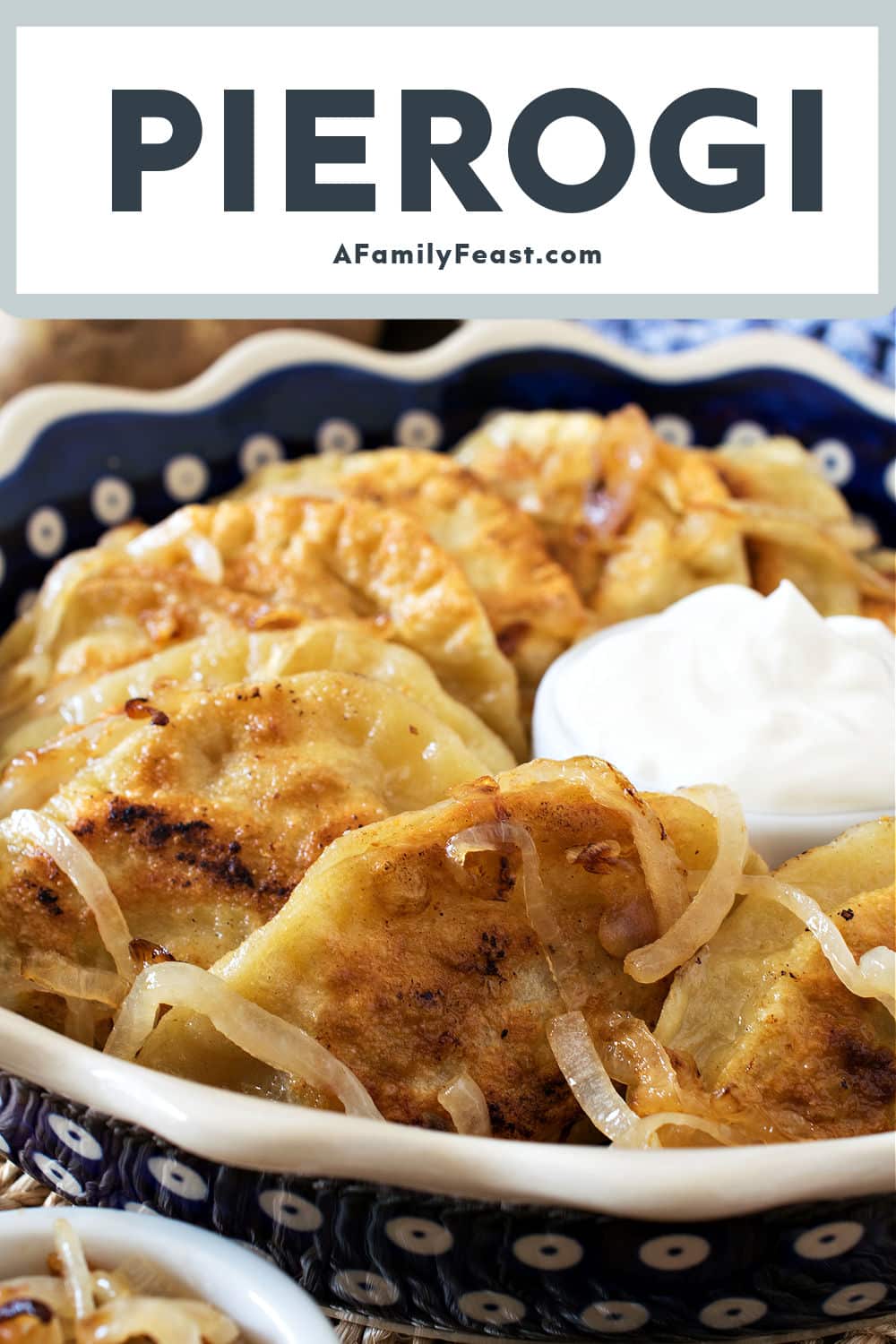

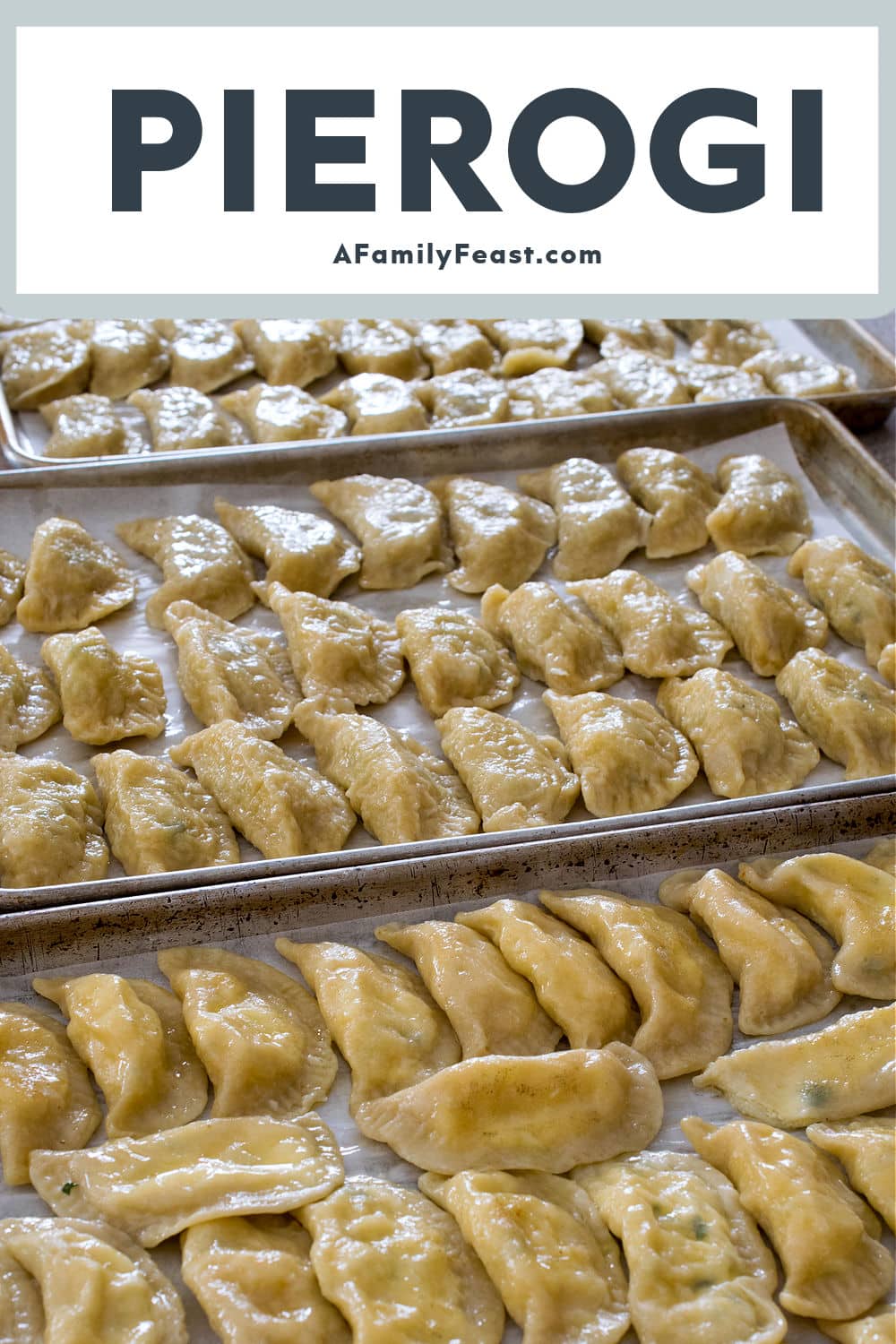
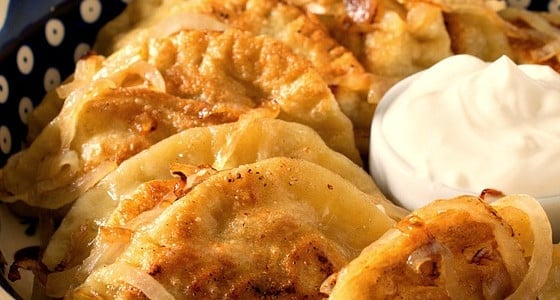
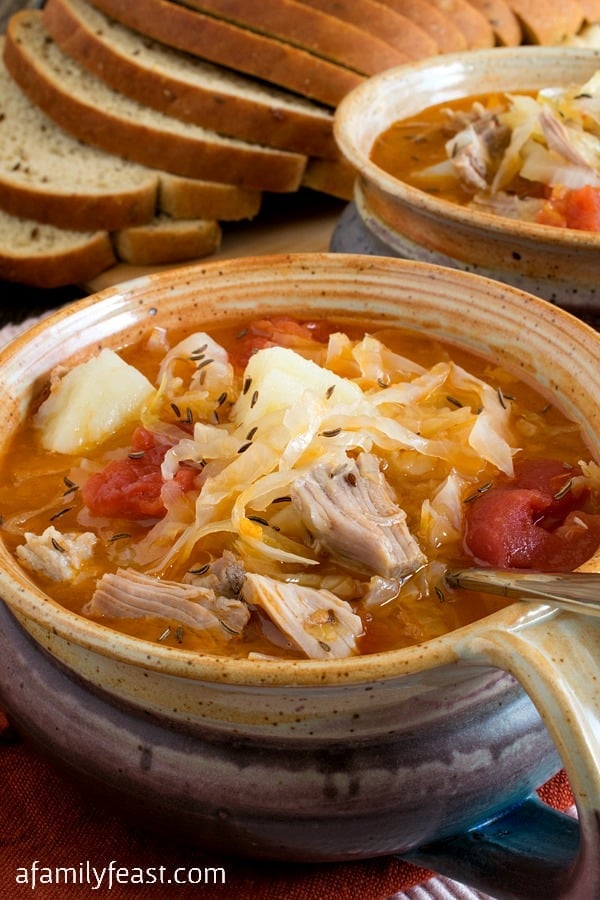
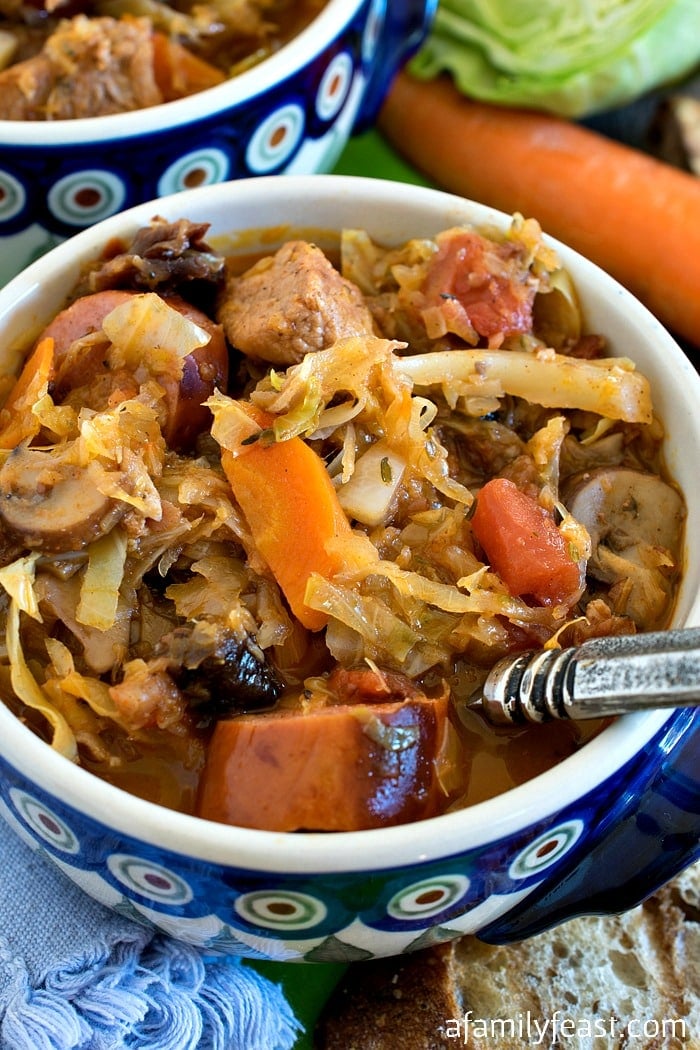
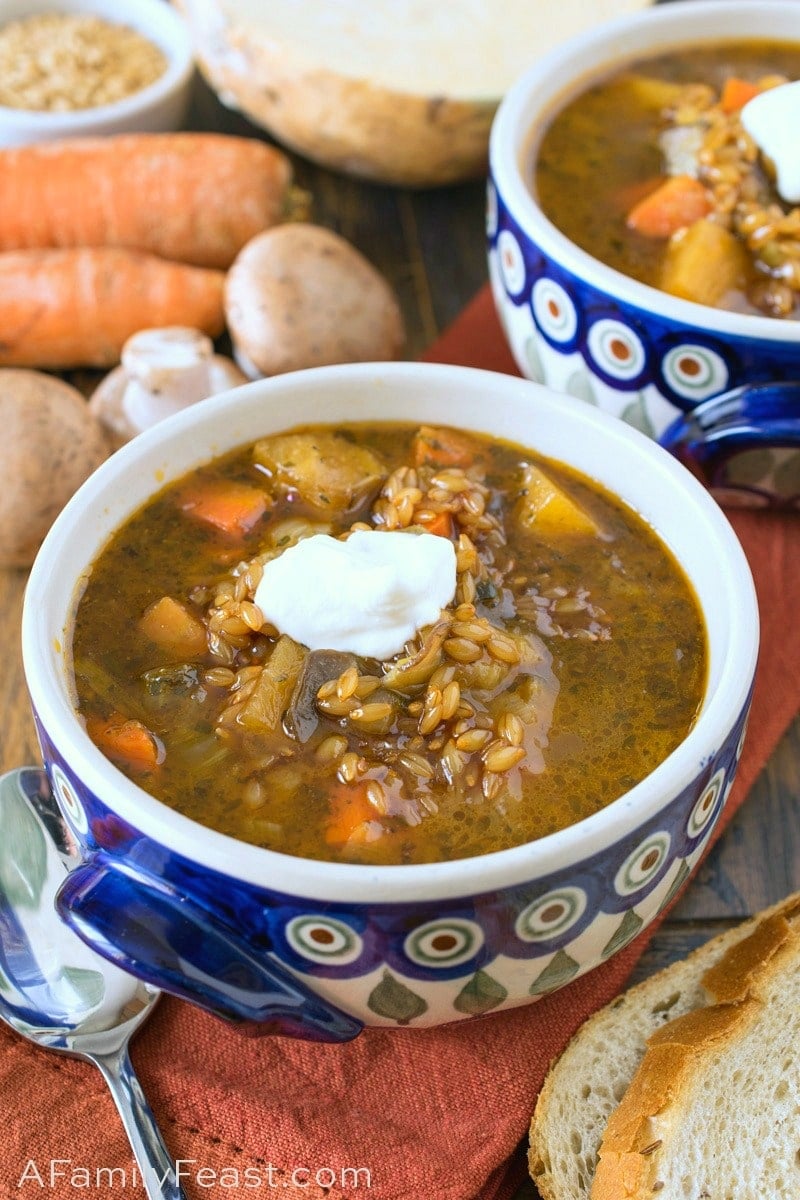
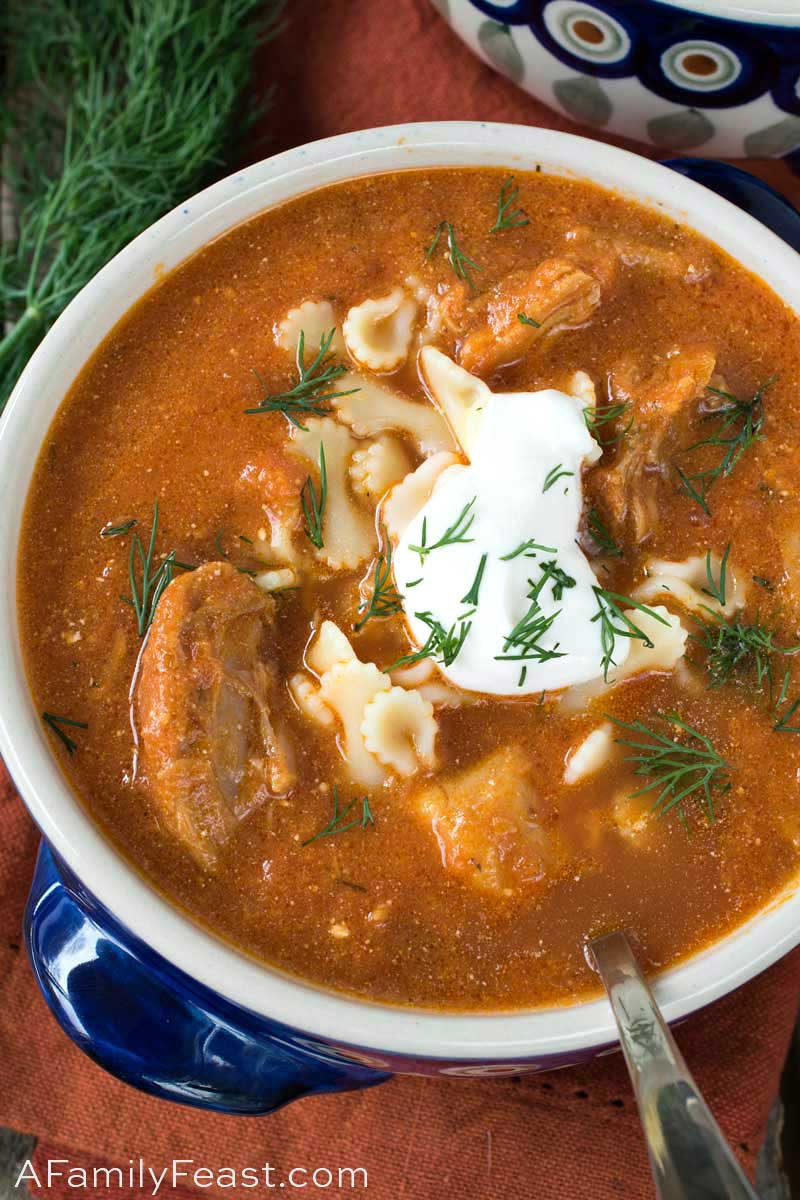
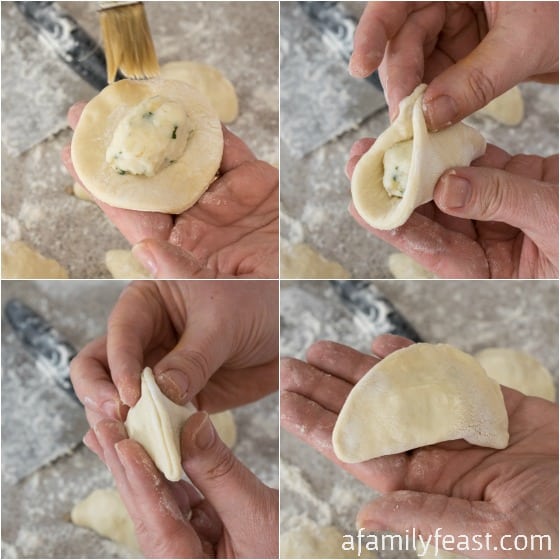
I am excited to try all the fillings and make us some dumplings! My girlfriend’s Polish Mum used to make a yearly trek from her home in Alberta out to Southern BC to make a huge batch of pierogi and my husband and I were always ecstatic to receive a big bagful (usually the potato cheese kind). Despite being an English/Scottish Canadian I was introduced at a fairly young age to freshly made pierogi by the grandma of a school friend. She was as Scottish as they come but married a Pole and learned to make all his favourite foods. All the neighbourhood kids would be crowded into their little kitchen with every bowl in the house used to serve up the freshly boiled pierogi, after they’d been rolled around in an enormous basin of sauteed onion and butter. Mmmmm. Now, I have a question for you – do you have a recipe for (and this is my guess at spelling) Ushki? My Polish / Spanish girlfriend’s Mamma from Madrid learned to make them for HER Polish husband as part of their Christmas Eve supper. I think it’s likely the lone Polish element of an otherwise Spanish menu. She has told me they are like little pierogi filled with a mushroom mixture, meant to be served in broth, and the name means “little ears”. Cheers!
Hi Liz! Thank you so much for writing to us. We hope you enjoy our recipe and what great memories you’ve shared! (Hope ours are as good as the ones you grew up with!) 🙂 So – I think you are talking about “uszka” and while we don’t have a family recipe for it – I did find this tutorial online which I thought looked great (and now I think we need to try making this ourselves too!) Here’s the link – hope this helps! and http://easteuropeanfood.about.com/od/uszka/ss/uszka.htm#step1
15 March 2016
Dear Liz;
You may be interested in knowing that many Slavic foods are complimentary in Eastern Poland, Western Ukraine, Czech Republic and Slovakia.
Pierogi, in Ukrainian is called “pyrohy” or Varenyky” as my Mother and Grandmother called them. In some regions of western Ukraine, fruit varenyky are called “Knedli”, a delicious dessert dish, which is a Czech word for dumplings.
Vushka are tiny varenyky, usually about the size of a walnut, and have their two corners joined together. This particular shape gives them a peculiar resemblance to tiny ears from which the name “vushka” is derived.
They may be filled with mushrooms, or meat, or fish, and are normally served as a soup accompaniment to clear borscht or broth on Christmas Eve. For this particular occasion, the filling should be meatless and without any animal fat…use mushroom or fish filling. Replace butter with a cooking oil or vegetable oil.
Roll the dough very thin and cut into 1.25 to 1.50 inch squares, and then proceed as for pierogi / varenyky.
Place 2-3 vushka in each serving of borscht.
David
Thanks David!
We grew up on them with the sauerkraut or potato filled. Do you have a recipe for, now not sure how to say it, kreushchegi? It was a similar dough I believe but my grandma would make them into bowties and deep fry them in hot oil then sprinkle powdered sugar on them. If you could find that for me I would so appreciate it.
Hi Reenie – I know exactly what you’re talking about – I remember that from the pastry/dessert tray during holidays! We did find a fried dough recipe in my mother’s old recipe box (it had a Hungarian name but sounds very similar to what you described) and plan to try it out soon. If it is a good recipe, we will definitely share it on our blog and I will let you know once we do!
Angle wings or Kruzcheki
4 egg yolks
1 large tablespoon sour cream
1 tablespoon powdered sugar
1 tablespoon rum
1 tablespoon vanilla
Mix above ingredients together until smooth
1 cup unsifted flour added to mixture.
Mix until you form a ball. Kneed until it blisters. After the dough blisters, cut the dough into four sections and roll each section paper thin. Cut out into strips. Cut a small slit into the center. Pull one end through the slit all the way.(this is the trickiest part, it gives it it shape, it is not hard, just hard to explain.) Deep fry, drain and sprinkle with powder sugar. This is Lucille Younis’ recipe found in WVIZ/PBS Cooks cookbook. I have made these with my sons for international day at school they taste like the ones my grandmother would make.
Thank you for sharing Patti! (we’re definitely going to try this recipe!)
Thank you for this recipe. I live in OK. And have not found a restaurant that serves them. My daughter and I will be making these. Again thanks for sharing.
You’re very welcome Doris! I hope you enjoy the recipe!
I love seeing the Pierogi served in Polish pottery. Just like a pattern I purchased in Germany. I’ve never made them, however we enjoy your recipe for Haluski.
Thanks Linda! (I thought the Polish pottery was the perfect serving dish for this recipe!) 🙂 We’re so glad you’re enjoying the Haluski recipe! Thanks for taking the time to write to us today.
Hi Martha,
I recall making pierogi from scratch many years ago when my daughters were young, and became a stroke victim, leaving my left hand/arm paralyzed with left sided weakness. Your recipe, with the addition of sour cream, has inspired me to try making these again. However, I have a question:
Since I realize the time-consuming effort of making the dough, can I do this same recipe using a food processor to make the pierogi with less strain by hand?
Hi Joyce – I’m so sorry to hear about your stroke! I definitely think you could use the food processor to mix the dough. We haven’t done it ourselves that way – but I’d love to hear how it turns out if you try it in the food processor! I hope you enjoy the recipe. Martha
My cousin and I did use the food processor and we even used my Pasta maker to kneed and roll out the dough in strips and then cut out the circles. Worked great for us! Give it a try.
Thanks so much Carol! We will! 🙂
I have learned to make these from my late Latvian mother-in-law. The only ones we made were ground sausage,chopped onion & spices. Extra dough was cut into noodles & boiled also. Boiled and served with sour cream. Leftovers are fried in butter & served with sour cream .All of her daughters, myself, granddaughters and now the great-grand children are learning to make these. If you like to eat them you need to learn to make them! sometimes we just make the dough for noodles.Thank you.
Sounds delicious Debra! We’ll have to try the ground sausage the next time…thanks for writing to us today!
Witaj!
You’re a great cook – you’ve done so many dumplings with various fillings. They look great, I think they taste like they look. Congratulations!
I correct your spelling: no “Coici” but “Ciocia” and “Babci” but “Babcia”. “Babci” is a variation of the noun. In Polish nouns have different forms. In the basic version should be “Babcia”. And there is no word “coici” in Polish.
Do not worry – reportedly Polish is the most difficult language of the world.
Congratulations photos! Yours!
Thank you Gosia! I think my family definitely “Americanized” the names but I appreciate the note about the correct spellings! My mother and grandmother used to speak Polish to each other in front of us kids whenever they wanted to talk in private (we had no idea what they were saying) – and other than a few words here and there we never learned the language! Maybe someday I will take a class! Thanks again for taking the time to write to us today! Martha
Everyone who had a Babci, knew what you meant. I am Polish and Russian and have Ukranians in the family. Everyone of us has variations. The heck with correct spelling. `You’re just fine in my book. There is also High and low and peasant variations. We’re all Americans for a reason, so we have freedoms and one of them is diversity in people and spelling. : ) Love your recipe for the dough and its just like my mom’s and my Babci’s. Love ya that you tried a variation and will keep reading and using your recipes. They’re a taste of home.
Thank you so much Sandy! 🙂 You made my evening!
We always said Babci and Cioci also. My grandchildren and great grandchildren call me Babci too.
Thanks Helen! (P.S. My mom and grandmother were both named Helen!) 🙂
dziekuje bardzo LOVED your site & recipes available immediately was great (hate sites that don’t provide recipes-sending to buy books or join….) brought back so many memories & motivated me to make this week not waiting for holidays to do but now called my sister suggesting we go together. God bless
Thank you! How wonderful – I hope you and your sister enjoy the recipes! 🙂
The steps on how to fill go from 2 to 4. Is there anything missing? Or is step 3 the photos?
Thank you for the recipe, looking forward to trying the dessert version.
Hi Karen – Thanks for your question – the recipe is complete as written. The skip in numbering is only from my adding the image – I couldn’t get my recipe widget to insert an image between steps without skipping a number! Thanks for checking! I hope you enjoy the recipe!
Thank you so much for posting these recipes. For more than 30 years my two aunties cooked Christmas Eve dinner and pierogis were one of the highlights of the meal. For years my sister, my cousins and I said “we need to learn how to make these!” Annnd we never did. One aunt has passed away and the other isn’t remembering things very clearly. I have looked for recipes like what I remember eating but some are so far off (broccoli? Really?) Yours are almost exactly what we had (no breadcrumbs on the prune but that sounds good) and I am thrilled to be able to pass these on to my relatives. It’s a lesson for all – don’t wait to learn from our elders! Thanks again.
Thank you Kathleen! I hope you’ll try our recipes and that they are as good as the ones you grew up with! (The breadcrumbs on the prune actually help cut down some of the sweetness – and it’s very good!) Thanks for writing to us today!
Pierogi are one of my favorites comfort foods! Mom learned to make them from a Polish neighbor and she would spend hours making them as the whole extended family came over when she did. There were never leftovers! We always had the potato and the sauerkraut ones. I make them now. Like you I found the addition of sour cream really made a difference. Yours look so good! I’ll be trying your fillings too. Love all your recipes.
Thank you so much Peggy Ann! I hope you enjoy trying some of the different fillings! Thank you for taking the time to write to us today!